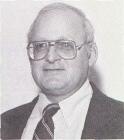 |
Home | Search | Browse | About IPO | Staff | Links |
 |
Home | Search | Browse | About IPO | Staff | Links |

Two-Way Left-Turn Lane
By JOHN McCREE
As our roadways become more congested we, as public officials, are faced with difficult decisions as to what remedy to use to resolve these problems. Balancing the conflict between safe, efficient traffic flow, access to abutting property, and public opposition often becomes a limiting constraint on design and traffic operations improvement alternatives. One alternative is the concept of the two-way left-turn lane (2WLTL). The 2WLTL allows simultaneous left turns from the center lane by vehicles traveling in the opposite direction. Vehicles from either direction of traffic flow enter the center lane to make left turns, thus removing themselves from the through lanes. This increases the capacity of the through lanes, reduces vehicular conflicts, and enables traffic to move more efficiently. In addition, the potential for rear-end, left-turn, and sideswipe accidents are reduced. The center lane can also be used to provide an emergency lane for traffic to bypass accidents and stalled vehicles and could allow emergency vehicles to more efficiently reach their destination. During 1983, the Village of Downers Grove applied the 2WLTL concept to improve Fairview Avenue with Federal-aid Urban (FAU) funds. Fairview Avenue was a north-south collector with an existing ADT of 14,500. The existing curb and gutter street was 27 feet wide through a residential section. The projected 20-year traffic was 16,000. Based on the projected traffic, and since Fairview Avenue required complete reconstruction, a four-lane, 52-foot cross section was required. The existing ROW was 66 feet, of which sidewalks occupied 10 feet, the street occupied 28 feet, leaving 28 feet for the parkways which contain a large number of mature trees. The 52-foot cross section would require the removal of 97 trees, leaving a one-foot parkway. To no one's surprise, the Village officials rejected the required alternate, principally because of neighborhood opposition. Following many meetings between IDOT, FHWA, Village officials and residents, a compromise was reached to construct a three-lane cross section. Although some neighborhood opposition still remained against the widening, the Village officials chose to construct the three-lane cross section. Following completion of construction, an accident study of the initial six-month period was done by the Village. This study was compared to the study performed six months prior to the construction of this project. Credits to: Veto Paulionis, Project Development Engineer
The overall accidents occurring in Downers Grove increased 14 percent during the time of the study. Rear-end type accidents decreased by 50 percent. Accidents caused by failing to yield the right-of-way at intersections decreased 33 percent. During the same six-month study period, traffic increased substantially due to motorists using Fairview Avenue as a detour route because of reconstruction of other routes in the vicinity. Even with the additional traffic, the Village officials report that there has also been a substantial improvement to the flow of traffic along with the decrease of accidents. In addition, many residents who opposed the construction of the additional lane are now pleased with the final product. Based on our experience, the 2WLTL does produce more orderly flow. At low and moderate traffic volumes the primary effects, are reduced conflicts and accidents. Reductions in delay and stops and increases in speed are generally not great because at these volume levels there is not significant congestion in the before condition. As volumes and congestion levels increase, reductions of stops and delay also increase and do become significant. Reductions in left-turn and sideswipe related accidents are also significant. On roadways where random unorganized access points are a contributing factor to safety, operational and/or capacity problems, the 2WLTL should be considered as a design alternative. •
Page 12 / Illinois Municipal Review / July 1987
|Home|
|Search|
|Back to Periodicals Available|
|Table of Contents|
|Back to Illinois Municipal Review 1987|
|
|||||||